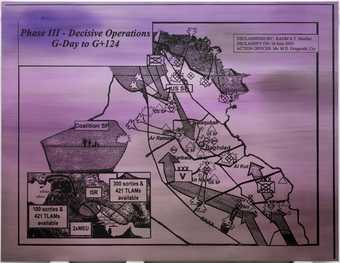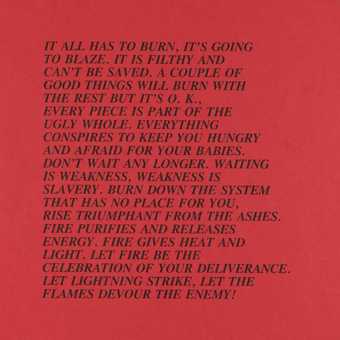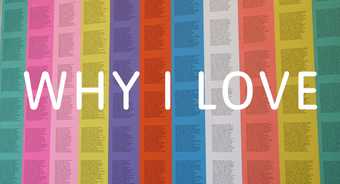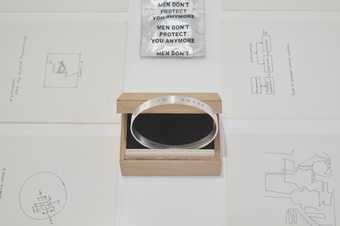
Exhibition view: ARTIST ROOMS: Jenny Holzer, Tate Modern, London, 2018 © 2018 Jenny Holzer, member Artists Rights Society (ARS), NY
Photo: Jack Hems
American artist Jenny Holzer presents statements that can provoke strong responses. Whether encountered on city streets or in art galleries, her work asks us to consider the words and messages that surround us.
Holzer’s art takes many forms, including stone benches, projections, signs, posters, paintings, plaques and textiles. Words are central to her work, whether pasted on a wall, flickering from an electronic sign, carved in granite or stitched in wool.
I chose language because I wanted to offer content that people – not necessarily art people – could understand.
Early in her career, Holzer delivered messages on posters and T-shirts so they would be seen in everyday places rather than in museums and galleries. Her work addresses the information overload and multiple perspectives we read daily. Eye-catching or quiet and lyrical, Holzer's art invites us to read and interpret for ourselves.
Her texts can be forceful and apparently simple, but may contradict one another. They are not necessarily straightforward expressions of the artist’s views. Truisms, Holzer’s first text series, is a survey of belief.
Holzer has described her aims:
I wanted a lot simultaneously: to leave art outside for the public, to be a painter of mysterious yet ordered works, to be explicit but not didactic, to find the right subjects, to transform spaces, to disorient and transfix people, to offer up beauty, to be funny and never lie.
Room One
While at art school, Holzer meticulously copied hundreds of captioned diagrams from library books, with subjects ranging from space and time to the behavioural patterns of children. She recorded the data by hand on sheets of paper, over 600 drawings in total. In Truisms, her first major text, written between 1977-79, she further explored gathering and presenting information as art. Starting with common sayings, clichés, and maxims, she composed nearly 300 slogans expressing many points of view.
With a sign or a poster in the street you have the space of time it takes a person to walk a few feet. With Truisms, I offer what will work in seconds, or in slightly longer blocks of time for people who are willing and able to concentrate.
At first she presented the phrases anonymously, printed on posters that she pasted on the streets of New York City. Holzer recalls, ‘I offered them up to myself and others, asking:
How do you cope—within and without—when all these views are present, sometimes clamouring, sometimes fighting, sometimes murderous?
She went on to print Truisms on objects such as condoms and disposable cups, as well as engraving them into silver spoons and bracelets. Electronic signs used for news, advertising and the financial markets offered another vehicle for the project.
Room Two
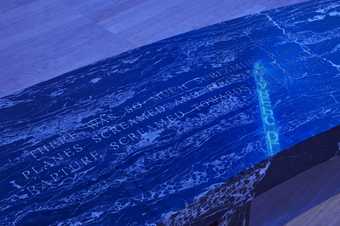
TOWARDS THE CLOUDS 2017
Text: "Earth and Sky" from Building the Barricade by Anna Świrszczyńska, English translation by Piotr Florczyk, © 2016 by Tavern Books. Used with permission of Ludmilla Adamska-Orłowska and the translator.
FLOOR 2015
Installation: ARTIST ROOMS: Jenny Holzer, Tate Modern, London, 2018 © 2017 Jenny Holzer, member Artists Rights Society (ARS), NY
Photo: Jack Hems
Holzer began making stone benches in the mid-1980s. Just as they function in city parks or cemeteries, the benches are both communal and commemorative, offering a place for contemplation or group discussion. Benches are one of the forms most associated with Holzer’s practice. In addition to inviting us to look and contemplate, they are functional and meant to be used.
The marble benches in the display feature excerpts of poems by the acclaimed Polish author, Anna Świrszczyńska, who wrote about her experiences as a nurse and member of the Polish Resistance during the Second World War. Holzer works with many kinds of stone and she carefully selects material that complements the engraved texts.
The Survival series was written for display on electronic signs, notably in New York’s Times Square in 1986. The texts also were cast as aluminium plaques. Each cautionary sentence instructs, informs, or questions the ways an individual responds to the political, social, physical, psychological and personal environments. ‘Protect me from what I want’ is a key Survival text.
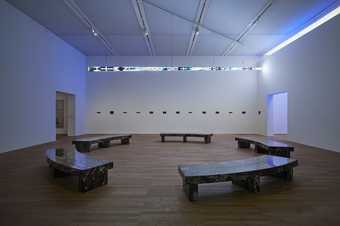
Exhibition view: ARTIST ROOMS: Jenny Holzer, Tate Modern, London, 2018 © 2018 Jenny Holzer, member Artists Rights Society (ARS), NY
Photo: Jack Hems
The Laments series consists of thirteen texts Holzer intended to be ‘voices of the dead.’ The Laments convey the last thoughts of ten adults, two children and an infant. She wrote the series at the height of the devastating AIDS epidemic in the late 1980s, when politicians were slow to respond to thousands of deaths caused by HIV-related illness. The texts represent unnecessary deaths, including those caused by, in the artist's words, 'bad politics'. This drawing was made in the process of carving text on thirteen stone sarcophagi.
The ceiling-mounted sculpture FLOOR 2015 was initially conceived to be shown on the ground, as its title suggests. Holzer often reworks her art to respond to its setting. She explores how the impact of her texts changes when presented in new materials and when seen from different vantage points. Customised programming renders Holzer’s Truisms, Inflammatory Essays, Living, Survival, Mother and Child, and Arno in an array of colours and effects meant to prompt a range of thoughts and moods.
Room Three
My legacy from coming of age in the 60s is that I want to make art that's understandable, that has some relevance and importance to almost anyone inclined to look. Once I've made the stuff, the idea is to get it to people. I want people to encounter the work in different ways, to find it on the street, to spot it on signs and on tractor hats. I like using many presentation modes, and motion. In electronic signs, I might turn writing purple and fly it upside down.
Holzer worked with New York graffiti artist Lady Pink to reinterpret texts from the Survival series. Holzer asked Ilona Granet, an artist specialising in sign painting, to hand letter the statements.
In the Living series, Holzer presents a set of quiet observations, directions and warnings. The text appears on cast bronze plaques, of the sort often installed on historical buildings, to lend the writing authority. In contrast to fast-moving LED signs and posters that can be torn down, bronze makes passing thoughts permanent.
Room Four
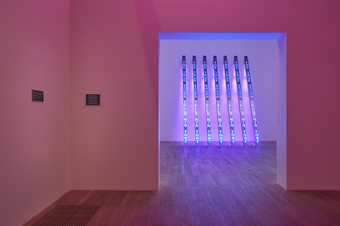
Exhibition view: ARTIST ROOMS: Jenny Holzer, Tate Modern, London, 2018 © 2018 Jenny Holzer, member Artists Rights Society (ARS), NY
Photo: Jack Hems
Blue Purple Tilt 2007 includes a survey of Holzer's writings, from the early Truisms and Inflammatory Essays through to Arno and Blue, done in the late 1990s. Holzer became interested in more sculptural LED presentations and so propped the electronic displays against the wall.
A great feature of the electronic signs is their capacity to move content. I love that because motion is much like the spoken word: you can emphasize phrases; you can roll and pause, the kinetic equivalent to inflection ... I write my text by saying the words out loud, or I write and then say words, to test them. Having text move is an extension of that process.
Room 5
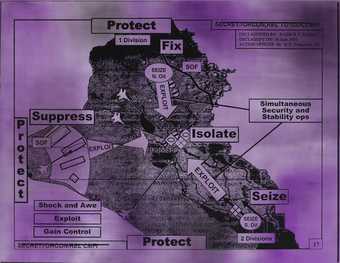
Jenny Holzer
Protect Protect
(2007)
ARTIST ROOMS Tate and National Galleries of Scotland
© Jenny Holzer, member/Artists Rights Society (ARS), New York
After September 11, 2001, Holzer started paintings of declassified United States government documents relating to intervention in the Middle East. You can see where some information in the original documents was redacted before release to the public. The paintings faithfully reproduce the original documents, apart from enlarging their scale and at times adding colour to emphasise the content. The two large paintings are slides from a PowerPoint presentation used to brief the White House in advance of the United States’ and UK’s invasion of Iraq. Note ‘Shock and Awe’ to describe military tactics. A small painting presents a document of ‘Alternative Interrogation Techniques.’
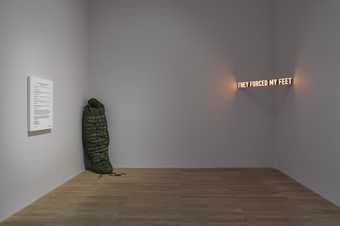
Exhibition view: ARTIST ROOMS: Jenny Holzer, Tate Modern, London, 2018 © 2018 Jenny Holzer, member Artists Rights Society (ARS), NY
Photo: Jack Hems
THEY LEFT ME 2018
Text: Interviews conducted by Human Rights Watch with former detainees, including women and children, and defectors from the Syrian military and intelligence agencies, 2011–12, from Torture Archipelago: Arbitrary Arrests, Torture, and Enforced Disappearances in Syria's Underground Prisons since March 2011, © 2012 by Human Rights Watch. Used with permission of Human Rights Watch. All names have been changed to protect identities.
I'VE JUST BEEN SHOT 2017
Text: Interviews with current and former members of the British military, © 2017 by the Not Forgotten Association. Used with permission of the Not Forgotten Association.
Holzer powerfully conveys the personal toll of warfare. The electronic sign in this room illuminates accounts by Syrian refugees collected by Save the Children and Human Rights Watch, as well as Anna Świrszczyńska’s poetry recounting siege experiences in the Second World War. An army-issue sleeping bag, slumped in the corner, evokes the human body it once held: it is stitched with first-person testimony of a British military veteran, contributed by The Not Forgotten Association.
Level 4 Concourse
IT IS GUNS: STUDENTS TALK SENSE 2018
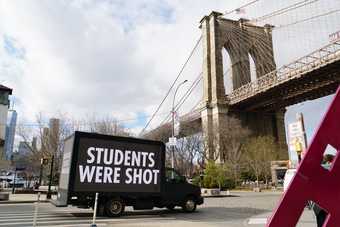
Jenny Holzer IT IS GUNS: STUDENTS TALK SENSE 2018
Jenny Holzer created this work in response to gun violence across the United States. She wrote the text to support students’ demands for gun control following the school shooting in Parkland, Florida, in February 2018. She presented the phrases anonymously on LED billboards mounted on lorries. These vehicles drove and parked by landmarks and city centres in Washington D.C., Los Angeles, New York City, Chicago, Atlanta and key locations throughout Florida.
Inflammatory Essays 1979–82
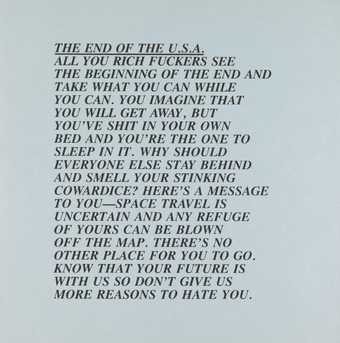
Jenny Holzer
[no title]
(1979–82)
Tate
© Jenny Holzer, member/Artists Rights Society (ARS), New York
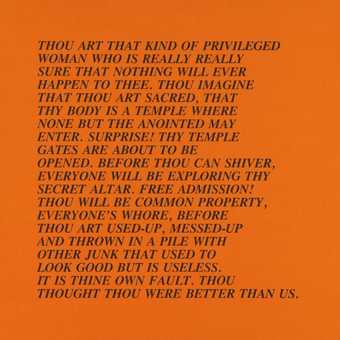
Jenny Holzer
[no title]
(1979–82)
Tate
© Jenny Holzer, member/Artists Rights Society (ARS), New York
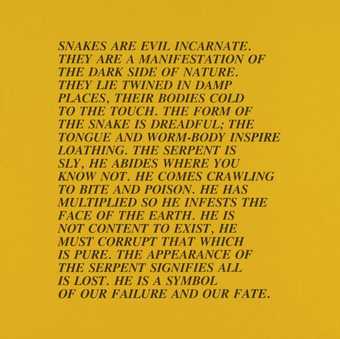
Jenny Holzer
[no title]
(1979–82)
Tate
© Jenny Holzer, member/Artists Rights Society (ARS), New York
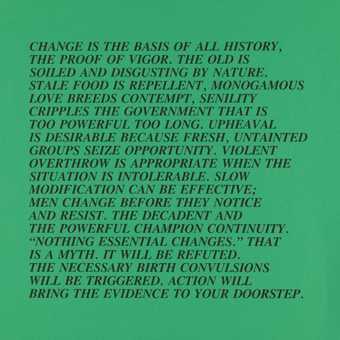
Jenny Holzer
[no title]
(1979–82)
Tate
© Jenny Holzer, member/Artists Rights Society (ARS), New York
The Inflammatory Essays present a range of provocative statements which were inspired by the texts of political theorists, religious fanatics and impassioned 'folk' literature. Since childhood, Holzer has been interested in 'rapturous writing' and wanted to write 'ecstatic, fantastic things'.
Each essay has exactly 100 words in twenty lines, and Holzer uses this rigid format to explore a range of extreme ideas. She questions the viewer's response by setting fanatical statements against the certainties of common opinion. Originally the Essays were fly-posted across New York City.
ARTIST ROOMS: Jenny Holzer is on at Tate Modern until 31 July 2019




